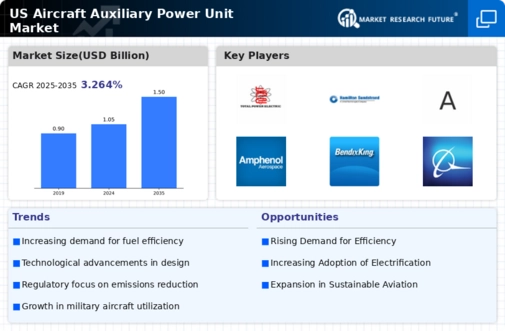The aircraft auxiliary power unit market is characterized by a competitive landscape that is increasingly shaped by technological advancements and strategic collaborations. Key players such as Honeywell International Inc (US), Pratt & Whitney (US), and General Electric Company (US) are at the forefront, focusing on innovation and sustainability to enhance their market positions. Honeywell International Inc (US) has been particularly active in integrating advanced digital technologies into its products, which not only improves efficiency but also aligns with the growing demand for environmentally friendly solutions. Meanwhile, Pratt & Whitney (US) emphasizes its commitment to reducing emissions through the development of next-generation power units, which positions the company favorably in a market that is progressively leaning towards sustainability.
The business tactics employed by these companies reflect a concerted effort to optimize operations and enhance supply chain resilience. The market appears moderately fragmented, with several players vying for market share, yet the influence of major companies is substantial. Localizing manufacturing and optimizing supply chains are common strategies that help these firms mitigate risks and respond swiftly to market demands. This competitive structure fosters an environment where innovation and operational efficiency are paramount, driving companies to continuously refine their offerings.
In November 2025, Honeywell International Inc (US) announced a partnership with a leading aerospace manufacturer to co-develop a new generation of auxiliary power units that leverage artificial intelligence for predictive maintenance. This strategic move is significant as it not only enhances product reliability but also positions Honeywell as a leader in the integration of AI technologies within the aerospace sector. The collaboration is expected to yield substantial cost savings for operators, thereby increasing the attractiveness of Honeywell's offerings in a competitive market.
In October 2025, Pratt & Whitney (US) unveiled its latest auxiliary power unit designed specifically for electric aircraft. This initiative underscores the company's commitment to innovation and sustainability, as it aims to reduce the carbon footprint of aviation. The introduction of this product is likely to resonate well with airlines seeking to meet stringent environmental regulations, thus enhancing Pratt & Whitney's competitive edge in the evolving market landscape.
In September 2025, General Electric Company (US) expanded its service network for auxiliary power units, enhancing its customer support capabilities. This strategic expansion is crucial as it not only improves customer satisfaction but also strengthens GE's market presence. By providing comprehensive support services, GE is likely to foster long-term relationships with clients, which is essential in a market where reliability and service quality are increasingly valued.
As of December 2025, the competitive trends in the aircraft auxiliary power unit market are heavily influenced by digitalization, sustainability, and the integration of advanced technologies. Strategic alliances are becoming more prevalent, as companies recognize the need to collaborate to stay ahead in a rapidly changing environment. The shift from price-based competition to a focus on innovation and technology is evident, with firms prioritizing the development of reliable and efficient products. This evolution suggests that future competitive differentiation will hinge on the ability to innovate and adapt to emerging trends, rather than merely competing on cost.





















Leave a Comment